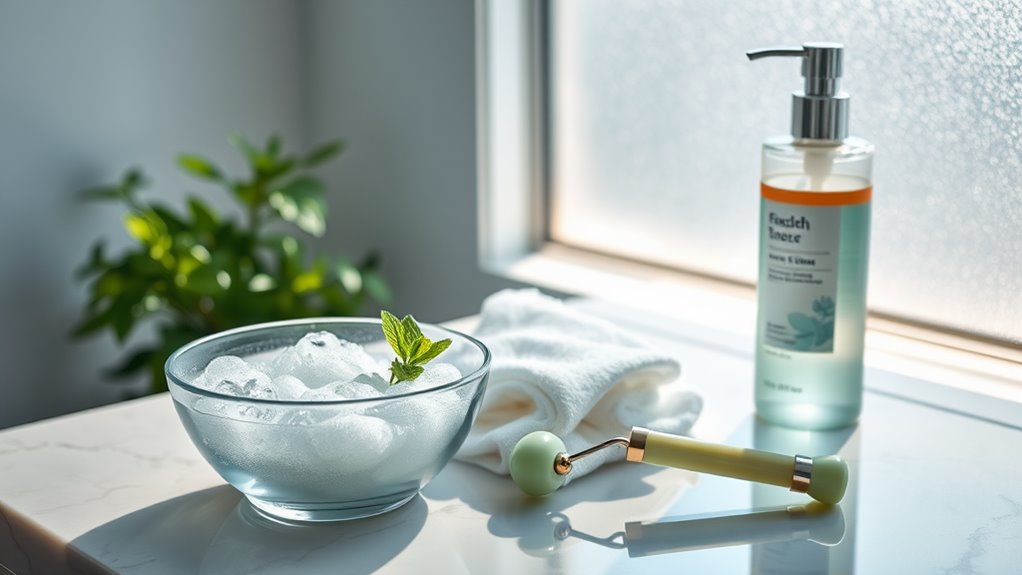The Best Way to Cleanse Your Face According to Experts
To cleanse your face effectively, start by identifying your skin type and choose a tailored cleanser. Experts recommend the double cleansing method: first, use an oil-based cleanser to dissolve makeup and impurities, followed by a gentle water-based cleanser for a deeper clean. Make sure you use lukewarm water and gentle motions to avoid irritation. Cleanse twice daily for best results and incorporate exfoliation 1-3 times a week. Discover more tips to enhance your skincare routine effortlessly.
Understanding Your Skin Type
Understanding your skin type is essential for effective cleansing and overall skincare.
Different skin types—oily, dry, combination, or sensitive—require tailored approaches.
For oily skin, opt for gel-based cleansers that control excess sebum.
Dry skin benefits from creamy cleansers that nourish and hydrate.
If you have combination skin, use a gentle foam that balances both oily and dry areas.
Sensitive skin needs calming, fragrance-free options to avoid irritation.
To accurately identify your skin type, consider performing an at-home test that helps you determine your specific needs.
These expert cleansing tips help you choose the right products, ensuring your skin remains healthy and radiant.
Importance of Double Cleansing
Double cleansing is essential for thoroughly removing dirt, makeup, and impurities from your skin. By starting with an oil-based cleanser followed by a water-based one, you guarantee that your skin is left clean and refreshed, minimizing the risk of breakouts and irritation. Understanding the steps for effective double cleansing can greatly enhance your skincare routine and improve your complexion. Additionally, double cleansing helps to promote healthier, clearer skin over time by ensuring that all traces of products and pollutants are eliminated.
Benefits of Double Cleansing
One of the key benefits of double cleansing lies in its ability to thoroughly remove makeup, dirt, and excess oil from your skin.
This method guarantees that your pores are unclogged, reducing the risk of breakouts and promoting a clearer complexion.
By starting with an oil-based cleanser, you effectively dissolve waterproof makeup and sebum.
Following up with a water-based cleanser provides a deeper cleanse, removing any remaining impurities.
Research shows that this technique can enhance the absorption of your skincare products, making them more effective.
Ultimately, double cleansing can lead to healthier skin and a radiant glow.
Steps for Effective Cleansing
When you prioritize effective cleansing, you’re not just washing your face; you’re laying the foundation for healthier skin.
Start with an oil-based cleanser to dissolve makeup and impurities. Gently massage it into your skin for at least a minute, then rinse with lukewarm water. Follow up with a water-based cleanser to remove any remaining residue.
This two-step process, known as double cleansing, guarantees your pores are thoroughly cleaned without stripping your skin’s natural oils.
Remember to use a gentle touch and avoid harsh scrubs, as they can irritate your skin.
Consistency is key for maintaining a clear, radiant complexion.
Choosing the Right Cleanser
How do you know which cleanser is best for your skin type?
Start by identifying your skin’s needs.
If you have oily skin, opt for a gel or foaming cleanser that contains salicylic acid or tea tree oil to control excess sebum.
For dry or sensitive skin, choose a creamy, hydrating cleanser with ingredients like glycerin or aloe vera.
If your skin is combination, a gentle, balancing cleanser will work well.
Always look for labels that specify non-comedogenic if you’re prone to breakouts.
Testing different products can also help you find the perfect match tailored to your unique skin concerns.
Additionally, understanding your skin type and optimal face-washing frequency can significantly enhance your cleansing routine for better results.
The Role of Water Temperature
The temperature of the water you use to cleanse your face can greatly impact your skin’s health.
Using the right temperature helps maintain your skin’s natural barrier and prevents irritation.
Here’s what you need to know:
- Warm Water: Opens pores for better cleansing.
- Hot Water: Can strip natural oils, leading to dryness.
- Cold Water: Closes pores, but may not remove dirt effectively.
- Lukewarm Water: Ideal for most skin types, providing a balanced approach.
- Consistency: Sticking to one temperature can help your skin adapt and thrive.
Additionally, using excessive face washing can disrupt your skin’s pH balance and lead to various skin concerns.
Choose wisely for best cleansing results!
Proper Cleansing Techniques
To achieve effective cleansing, it’s essential to choose the right cleanser for your skin type, as this can greatly impact your skin’s health. Following a consistent routine helps maintain your skin’s balance and prevents issues like dryness or breakouts. Incorporating double cleansing techniques can enhance your cleansing routine by ensuring the removal of both oil-based and water-based impurities.
Choose the Right Cleanser
When selecting a cleanser, what factors should you consider to make sure your skin stays healthy and balanced?
Choosing the right cleanser is essential for your skin type and concerns.
Here are some key points to keep in mind:
- Skin Type: Identify if you have oily, dry, combination, or sensitive skin.
- Ingredients: Look for effective and gentle ingredients, like glycerin or salicylic acid.
- pH Balance: Aim for a pH-balanced formula that won’t strip your skin.
- Texture: Consider whether you prefer gel, cream, or oil-based cleansers.
- Allergies: Avoid known irritants and allergens to prevent reactions.
Follow a Consistent Routine
Finding the right cleanser is just the first step in maintaining healthy skin; establishing a consistent cleansing routine is equally important.
Aim to cleanse your face twice daily—once in the morning and once before bed.
Use lukewarm water to open pores, then apply your cleanser gently, using circular motions for about 30 seconds.
Rinse thoroughly to remove all residue.
Don’t forget to tailor your routine to your skin type; oily skin may benefit from gel cleansers, while dry skin often needs cream-based options.
Consistency is key—regular cleansing helps prevent breakouts and keeps your skin looking vibrant and healthy.
Frequency of Cleansing
Cleansing your face regularly is essential for maintaining healthy skin, but how often should you do it?
Experts generally recommend washing your face twice a day—once in the morning and once before bed.
This routine helps remove dirt, oil, and impurities, promoting clear skin.
However, consider your skin type and lifestyle:
- Oily skin: Twice daily to control excess oil.
- Dry skin: Once daily to avoid stripping moisture.
- Sensitive skin: Gentle cleanser once or twice daily.
- Post-exercise: Always cleanse after sweating.
- Makeup wearers: Double cleanse to guarantee thorough removal.
Incorporating double cleansing essentials into your routine can significantly enhance the effectiveness of your cleansing process.
Find what works best for you!
Incorporating Exfoliation
How often do you think about exfoliating your skin? Regular exfoliation isn’t just a luxury; it’s essential for maintaining a healthy complexion. Aim to exfoliate 1-3 times a week, depending on your skin type. Here’s a quick reference to help you choose the right exfoliant:
| Skin Type | Exfoliant Type | Frequency |
|---|---|---|
| Oily | Chemical (AHAs/BHAs) | 2-3 times/week |
| Dry | Gentle Scrubs | 1-2 times/week |
| Combination | Both | 1-3 times/week |
| Sensitive | Enzyme Exfoliants | Once/week |
| Normal | Any | 1-2 times/week |
This routine enhances cell turnover, revealing brighter skin. Additionally, selecting the right type of exfoliator can significantly improve your skin’s texture and overall health.
Post-Cleansing Care
Once you’ve cleansed your face, it’s crucial to follow up with the right post-cleansing care to maintain your skin’s health and hydration.
Proper aftercare can enhance your skin’s barrier, prevent irritation, and keep it looking radiant.
Here are key steps to follow:
- Apply a toner to balance pH levels.
- Use a serum rich in antioxidants for added protection.
- Moisturize to lock in hydration and nourish your skin.
- Incorporate sunscreen during the day to shield from UV damage.
- Consider facial oils for extra hydration, especially in dry climates.
Follow these steps for ideal skin health!

